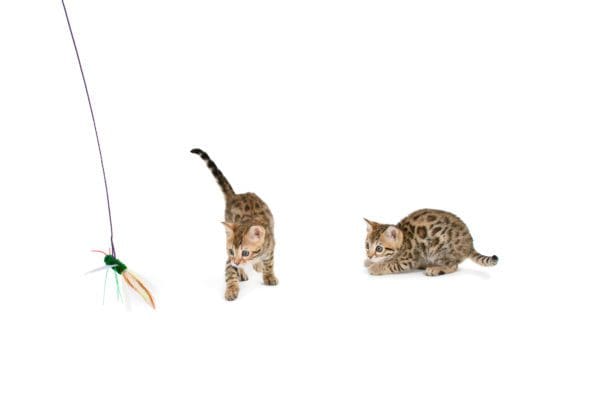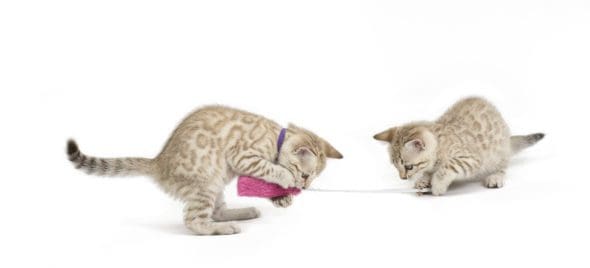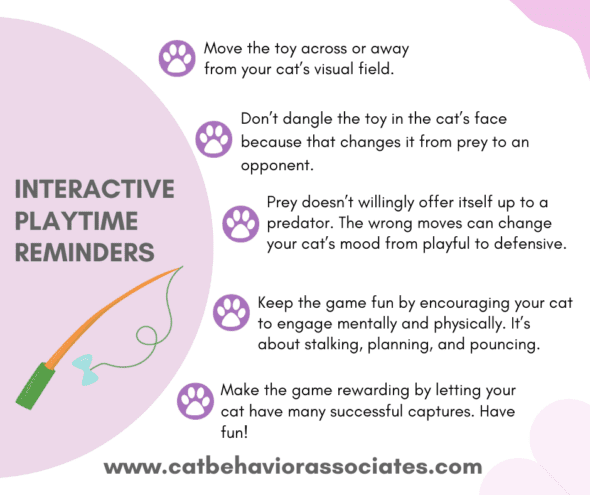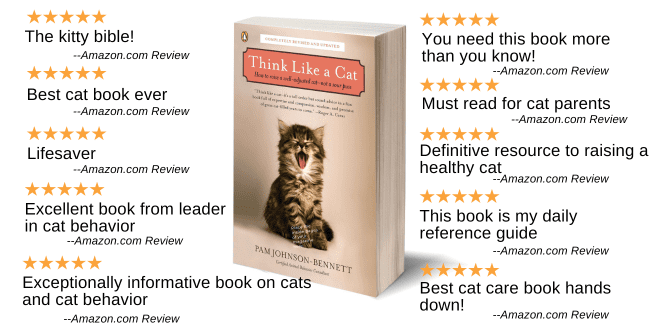
Cats at play. It’s an image many assume cats do all by themselves quite easily and frequently, without the need for our interference. Sadly, cats aren’t getting enough playtime. This is due to factors such as boredom, stress, fear, no environmental enrichment, the human family’s busy schedule, and the list could go on. Cats need playtime for mental, physical, and emotional health. Too many indoor cats are becoming feline couch potatoes with the only exercise coming in the form of the walk to the food bowl and litter box.
What is Interactive Play?
This type of playtime involves you. Your cat has all kinds of toys for solo playtime but interactive play is special because he doesn’t have to do any extra work to make the toy come to life — you are in charge of that part of the game. Using a wand toy (fishing pole design), you make the “prey” come alive through your movements. These movements trigger the instinct in the cat to stalk, chase, pounce and capture. Most interactive toys have a target toy attached to a string that dangles from the end of a wand. Basically, the string part becomes invisible as the cat intently focuses on the movements of the prey target. You control whether the prey flies, slithers, quivers, hides or jumps.
1. Playtime and a Cat’s Mental and Physical Health
Physical health and exercise are the most obvious benefits of playtime that most people understand. Play helps cats keep in tip-top body condition, aids in preventing obesity, helps maintain mobility and is an outlet for working off built-up energy. For some indoor cats, there is often limited opportunity for sufficient exercise if cat parents don’t initiate it through play.

Photo: Rompicatz
For senior cats, playtime can help maintain cognitive function and assist physical mobility by movements that gently work those stiff muscles and joints. For kittens, playtime is a learning tool for budding physical abilities such as balance, speed, coordination, accuracy, and sensory development. Playtime for kittens provides a critical education for future survival as they learn essential skills for stalking and capturing prey. Interactive playtime also teaches kittens to direct their teeth at toys and not human fingers – something cat parents appreciate as kittens transition to adulthood with adult-size teeth.
2. Interactive Playtime Builds Confidence
For timid or fearful cats, interactive play lets them remain at a comfortable distance and still enjoy the fun. The wand toy helps you build trust and gives the cat the choice of how close to get. Used correctly, it’s a confidence-builder as the cat engages the instinct to stalk, pounce, and capture. When you play in this way, a scared cat will feel more comfortable and may gain enough trust to venture out of a hiding place to pursue the toy, knowing kitty always has the choice to retreat and that you aren’t too close. Each play session builds on the previous one to help a cat feel safe.
3. Interactive Play Helps Strengthen Bonds
Playtime can help your cat make positive associations with your presence. If there’s a new cat in your life, interactive play is an ideal way to begin creating a bond and help the newcomer become familiar with the environment. If someone new has come into your family, you can show them how to use interactive playtime to start developing a relationship with your cat. I often tell clients to find a special interactive toy that only the new family member uses so it becomes a very special event for the cat.
Use playtime to help a new cat integrate into a home where there is already a resident kitty. Food is a powerful motivator for making positive associations, but playtime is right up there as well. Don’t ask the cats to share one toy though. Do parallel play by either having a wand toy in each hand or enlist the help of a family member. That way you don’t risk one cat intimidating another as they compete for the same toy.

Photo: Rompicatz
4. Beat Boredom with Interactive Play
Is your cat bored? If so, they may seek stimulation in counter-productive ways. Playtime provides stimulation in fun, healthy, rewarding ways. It gives your cat the chance to refine cognitive and physical skills. The key though is for playtime to be done correctly and frequently.
Outdoor cats who must depend on their hunting skills to survive have plenty of prospects for exercise and stimulation through hunting. There are obvious dangers to outdoor life for a cat though. Indoor life is, in my opinion, much safer for cats but they still have that instinct to hunt, which is another reason to provide interactive playtime. Through this type of play, your cat can enjoy what it means to be a cat without having to worry about where the next meal is coming from.
5. Behavior Benefits of Interactive Play
Interactive play is an underused tool when it comes to preventing or correcting behavior problems. It’s a valuable aspect of a behavior plan when dealing with fear, aggression, boredom, depression, intercat conflict, introduction of a new pet or family member, cognitive decline, distress, and more. If you have a strained multicat household, interactive playtime may help redirect one cat’s focus away from another cat and onto the toy. This can be helpful in diffusing a potentially disagreeable altercation. If doing an introduction of a new cat into an already established cat household, playtime is beneficial in helping the cats develop more positive associations with each other.
If the problem is that your cat displays aggression toward human family members, interactive playtime will help, along with the correct behavior work, in teaching the appropriate object to attack.

Photo: Rompicats
6. Easier Transitions Through Life
Cats don’t like change, especially unexpected ones, but life can throw you unavoidable ones. In addition to specific behavior work to help ease your cat’s anxiety about new things being introduced into their life, the consistent, constructive interactive play sessions can go a long way in making those changes a little more tolerable. Whether it’s a move to a new home, renovation of your current home, new family addition, work schedule change, etc., it will help if your cat has as much consistency and predictability as possible. Twice daily interactive play sessions that he can count on provides that much needed extra bit of reassurance.

7. Interactive Playtime is Fun
Who doesn’t want more fun in life? Throughout your cat’s life, playtime should always be done. Customize the game to fit your individual cat’s stage of life, physical ability, cognitive strength, health and play preferences. For maximum appeal, pay attention to any toy preferences your cat may have. For example, a timid cat may prefer a smaller toy that seems easier to capture. Some cats like soft-textured toys that feel more prey-like when bitten. Other cats may like toys that make enticing sounds. Feathers may also top the list for many kitties. Note how your cat likes to play and what toys provide the texture, size, sound, and movement most tempting, and you’ll be well on your way to creating state-of-the-art interactive play sessions.
No matter what type of toys you choose, keep in mind that how you move them can make or break the play session. To trigger the right response, move the toy across or away from your cat’s visual field. It’s that type of maneuvering that more closely resembles how prey would react when encountering a predator. Don’t try to entice your cat into playtime by dangling the toy right in his face or running it back and forth over his body. Incorrect movements can lower the fun factor and potentially just aggravate your cat. Think like prey so your cat can be the mighty hunter. And don’t forget about the joy of successful captures. Don’t keep a toy constantly out of reach because that just ends up being frustrating. To be truly enjoyable, make sure your cat gets plenty of successful mini captures throughout the game and then one final grand capture at the end. Wind the action down as the game comes to a close to let your cat know he has successfully exhausted the prey. End the game by giving your feline hunter a food treat or time the play sessions right before mealtime.
Try to schedule at least two play sessions a day that last about 15 minutes each. It may seem difficult to carve out that time daily, but the long-term benefits are surely worth it for your much-loved feline family member. Remember, keep it fun, recurrent, and rewarding and your cat will be purring with joy.
Need More Information?
If you aren’t sure what type of toys to get for your cat, you may have to do some toy testing to see if he has any toy preferences. The pictures I’ve featured in this article are of the RompiCatz Toys (Pet Ki Enterprises). There are also many other wonderful brands. RompiCatz has a wide variety of well-made toys with high cat appeal that top my list when talking to clients about playtime for cats. The Cat Dancer (Cat Dancer Products, Inc) is another good brand. Cat Dancer is an age-old classic that’s hard to beat for play enticement and durability. Another good toy is Da Bird (Go Cat) but as I said, there are other good brands. Just be sure, when shopping for toys, they are well-made and safe.
For more information on cat behavior and training, refer to the books by best-selling author Pam Johnson-Bennett. The books are available at book stores as well as online. We’ve included Amazon links on our website.
.
 Problem Solving & Advice by Pam Johnson-Bennett Cat Behavior Expert & Best-selling Author
Problem Solving & Advice by Pam Johnson-Bennett Cat Behavior Expert & Best-selling Author




